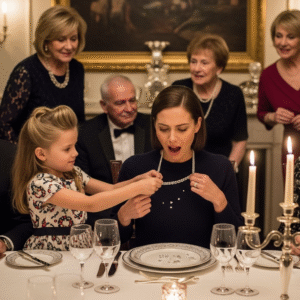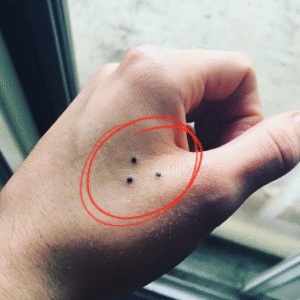A Frightening Morning
My name is Isabelle Laurent. I learned that sometimes the people who are supposed to help you are the ones who hurt you most—until someone who loves you steps in.
The maternity reception at St. Claire’s Medical Center in Philadelphia felt colder than it should. Pale blue walls reflected the harsh overhead lights. The air smelled faintly of antiseptic. There was no comfort, no warmth for a woman in pain.
I was twenty-nine, seven months pregnant, and terrified. That morning, persistent cramps sent me into a panic. Dr. Monroe, my obstetrician, had urged me to come immediately. His urgent tone left my hands shaking as I grabbed my purse and called a taxi.
I expected reassurance. Instead, I received humiliation.
The Reception
At the front desk, Nurse Brenda Wallace sat like a gatekeeper. Her graying hair pulled back, her demeanor cold. She barely looked up as I approached.
“Good afternoon,” I said softly. “My name is Isabelle Laurent. Dr. Monroe told me to come in right away. I’m having abdominal cramping.”
Brenda’s eyes scanned me briefly, without warmth. “Do you have an appointment?”
“I was told it was urgent,” I explained, pressing my hand against my belly. “He said someone would be ready for me.”
She exhaled sharply. “You people always think you can just show up without following proper procedures. Sit down. We’ll get to you when we get to you.”
Her words stung. I felt humiliated, reduced to something less than human. I had spent my career earning respect. Never had anyone treated me with such disdain.
“I’m worried about my baby,” I whispered. “Could you please confirm with Dr. Monroe?”
She smirked. “Or perhaps you’re exaggerating to skip ahead. We have actual emergencies.”
Around me, other patients shifted uncomfortably. Some stared; some looked away. No one spoke.
The Wait
I sank into a plastic chair, clutching my abdomen as cramps intensified. Twenty minutes passed like hours. Fear gnawed at me. Every medical show I had ever watched replayed in my mind—all the ways things could go wrong.
Finally, I forced myself to the reception desk. Legs unsteady, I gripped the counter.
“Please,” I whispered. “The cramping is worse. I need someone to see me.”
Her expression hardened. “If you keep disturbing others, I’ll have to call security.”
Before I could react, she reached for her phone. Her voice carried across the room:
“I need officers at maternity reception. We have a disruptive patient.”
The Police Response
The waiting room fell silent. I pressed my hands to my belly, tears blurring my vision. Officers approached, uncomfortable.
“Ma’am, we received a call about a disturbance. Can you explain?” one asked gently.
Before I could respond, another voice cut through the tension.
Marcus Arrives
My husband, Marcus, strode through the doors with purposeful energy. Six-foot-two, broad-shouldered, steel-gray eyes. He carried a presence that demanded attention.
“Sir, are you related to this patient?” one officer asked.
“Yes,” Marcus replied, moving to my side. “I’m her husband. I want to know why my pregnant wife is in tears with police standing over her instead of being seen by medical staff.”
Brenda opened her mouth to argue, but Marcus didn’t let her. “My wife called me crying. I left a board meeting to come here immediately. If this is how St. Claire’s treats expectant mothers, we have a serious problem.”
Brenda’s face went pale. Whispers spread through the waiting room.
“It’s okay, sweetheart,” Marcus said, stroking my hair. “I’m here now.” Then to the officers: “She’s a patient in distress, not a disturbance.”
One nodded. “Understood, sir. We’ll step back.”
The Medical Response
As if summoned, Dr. Peterson appeared. “Mrs. Laurent? Dr. Monroe called ahead. Please come with me immediately.”
At last, I was treated like a patient, not a problem. Marcus guided me to the examination room. “This isn’t over,” he said, addressing the waiting room. “Patient dignity isn’t optional.”
Inside, monitors confirmed my baby’s strong heartbeat. “Your baby is perfectly fine,” Dr. Peterson said. “You did the right thing coming in.”
Relief washed over me. Tears fell, this time tears of joy. Marcus held my hand. “See? Our little fighter is doing fine. You trusted your instincts perfectly.”
The Investigation
Word spread quickly. Witnesses spoke up. The hospital launched an investigation. Security footage and statements confirmed the unprofessional behavior.
Nurse Brenda Wallace was placed on administrative leave. The chief nursing officer personally apologized.
But my victory wasn’t in the disciplinary action. It was in the steady heartbeat, in Marcus’s immediate support, in knowing I had an advocate who refused to let anyone diminish my worth.
Preparing for Parenthood
Three weeks later, I returned to St. Claire’s. The reception area had changed. New protocols. Trained staff. A warm, attentive receptionist.
“Mrs. Laurent,” she said, smiling. “Dr. Monroe is ready. How are you feeling today?”
Marcus and I reflected on the ordeal. We realized it had taught us the importance of advocacy—not just personally, but institutionally.
The Birth
Two months later, we returned for labor. The experience was completely different. Staff were attentive and respectful.
Our daughter, Sophia Marie Laurent, was born healthy. Marcus held her, tears streaming. “She’ll grow up knowing she deserves respect,” I whispered.
“And if anyone tries to tell her otherwise,” Marcus replied, “we’ll remind them who they’re dealing with.”
The Story We Tell
We tell Sophia this story not as victimization, but as an example of love and advocacy transforming injustice. We teach her to speak up and defend others.
The incident showed us that bias exists where we are most vulnerable. It also showed that having an advocate can change everything.
Looking Forward
Today, Sophia is a curious toddler, gently “examining” her stuffed animals. She models care and respect without even knowing it.
The experience became a family story of resilience, advocacy, and love. Marcus and I now participate in patient advocacy and civil rights initiatives, using our experience to help others.
The lesson is simple: dignity isn’t negotiable, advocacy matters, and showing up for the people you love can change everything.
Our daughter will grow knowing she is worth fighting for—and that her parents will always remind the world who they’re dealing with.





